A Good Foundation for the Future.
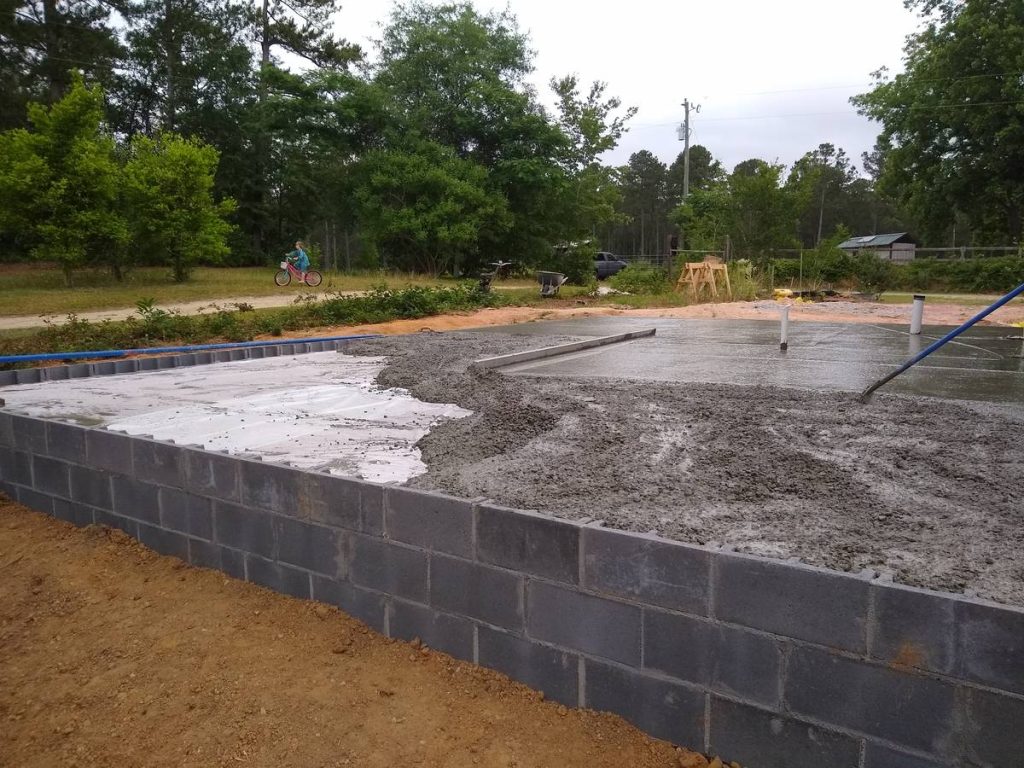
Growing up, company coming over always caused a flurry of activity. The house had to be made ready for the visitors. Rooms had to be vacuumed and swept, toys put away, and clutter carefully hidden in rooms and out of sight. Not that the guests particularly cared about the cleanliness of our house, but we cared. At least Mom cared.
The same thing happens when preparing for a building inspection. Except for one important difference. The inspector actually does care if you’re prepared. He actually looks for problems that will need to be fixed before you move on to the next stage. And that means that I cared.
But I also have this ticking clock. Mama needs more space. So the time to get the inspection done is RIGHT NOW. We can’t pour the concrete until we pass the inspection.
Preparing for company.
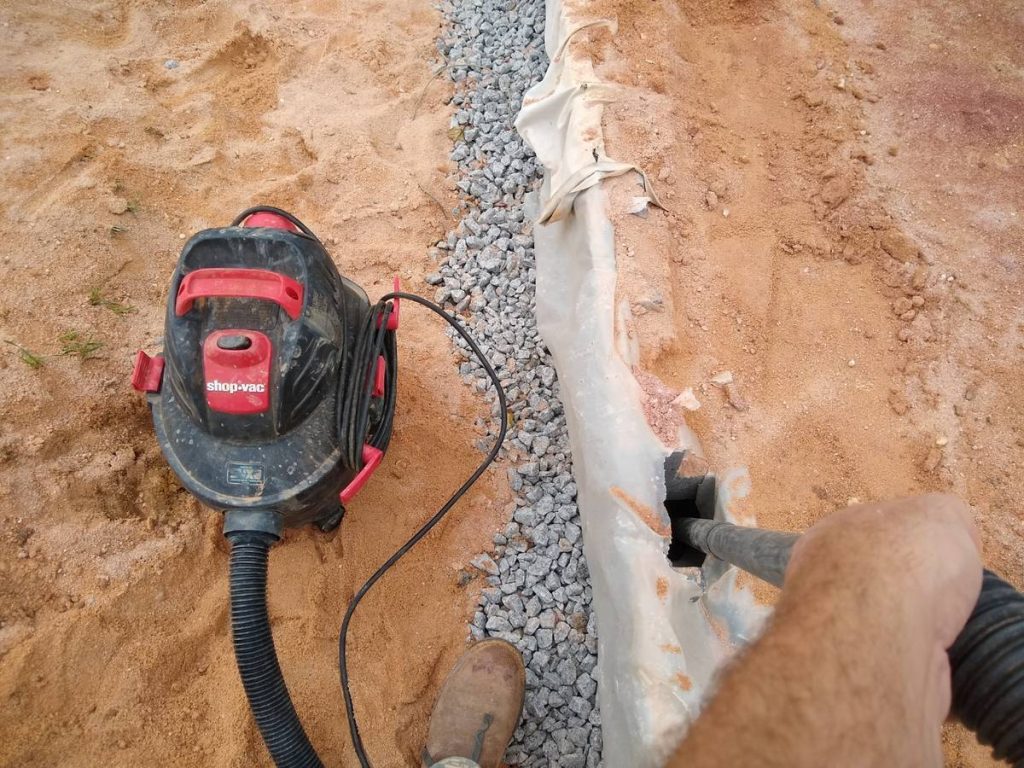
There’s a kind of company that you welcome like a hostile invasion, laying traps and landmines. Termites. Termites devour houses the way my children eat ice cream sandwiches. They create a gigantic mess, eat away the essential middle, and destroy the essential structure beyond recognition. To pass the inspection, I needed to get a pest control company to come to treat the slab and give me a termite letter.
I found a company called Riggins Pest Solutions which does the slab treatment (not every pest control company does) but they said that they didn’t have any open slots until Thursday. Since I wanted to have the inspection Thursday, this posed a bit of a scheduling problem. I told them that I’d call them back and made a bunch of calls. I couldn’t find another pest company that would even give me a quote over the phone. NGAAAA.
I called Riggins back prepared to push the date of the inspection, and the nice lady on the other end of the line told me that a time slot opened up on Tuesday. Praise the Lord! I booked the appointment. Tuesday came and so did the bug guy. The termite treatment is pretty simple. Dump a bunch of termite poison into the concrete block and over the compacted sand, especially where it joins the house.
In the meantime, I had to break out the old Shop-vac and clean the sand out of the concrete block wall. A bunch of sand had fallen in when we filled the foundation, and I had to make room for the termite treatment and the concrete to fill the block. There isn’t much more that needs to be said about a vacuum that can remove 200 pounds of sand.
Final Preparations.
With the termite letter done, I had four final steps to complete: gluing the concrete expansion barrier to the wall, putting down the vapor barrier, cutting pieces of rebar for the concrete block, and setting up the pressure test for the drain system. I had until Thursday to get it done.
Larry came over Wednesday night to help. I got the compression barrier done before he showed up. The expansion barrier is a four-inch-wide strip of squishy foam that I glued to the wall where the concrete would come in contact with the existing house. The concrete expands and contracts with the external temperature and the barrier protects the old house. I popped a chalk line and glued it in place with silicone.
Larry has a handy little battery-operated angle grinder that he used to cut the rebar while I laid out the vapor barrier. If you’re like me and have never poured a concrete slab, you might not know what a vapor barrier is. I didn’t either. Concrete is not waterproof. Water can seep through it. This can be a real problem if you’re talking about your floor. The vapor barrier is a thick sheet of plastic that goes down on the sand to prevent moisture from wicking up through the sand and concrete into your home.
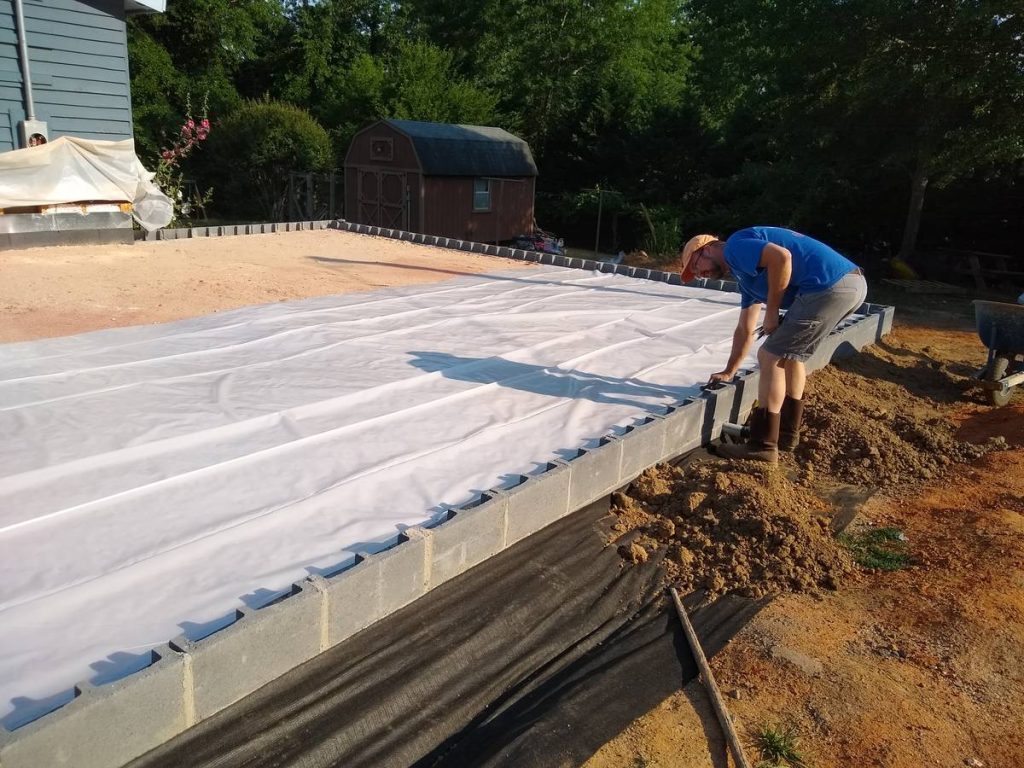
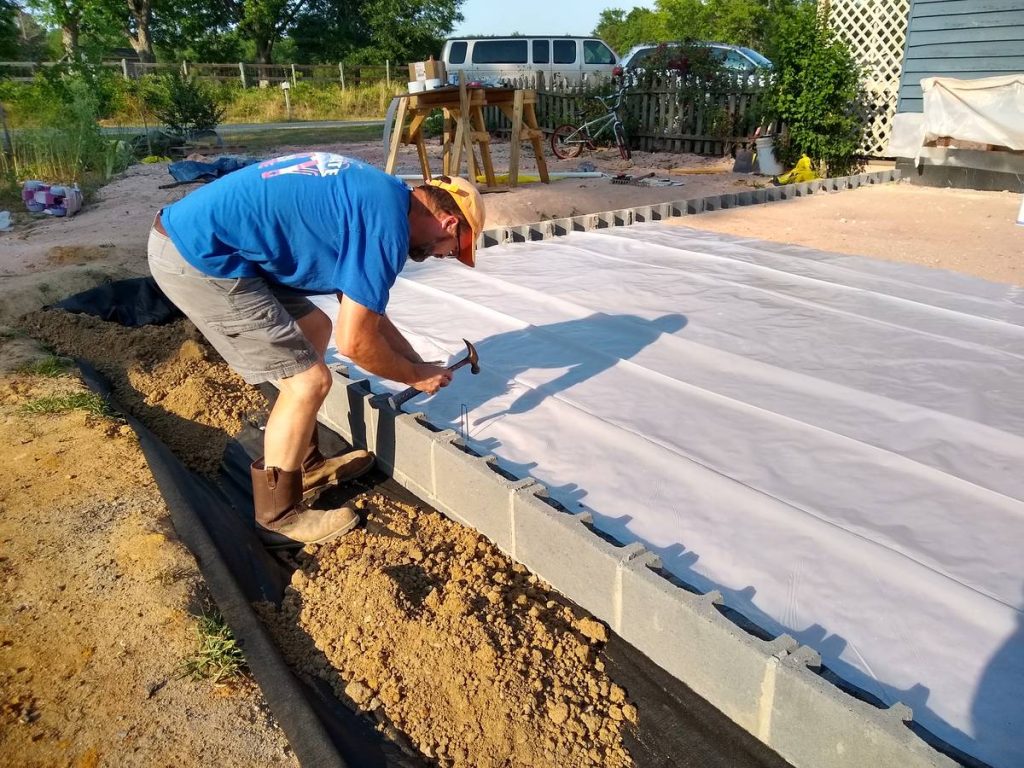
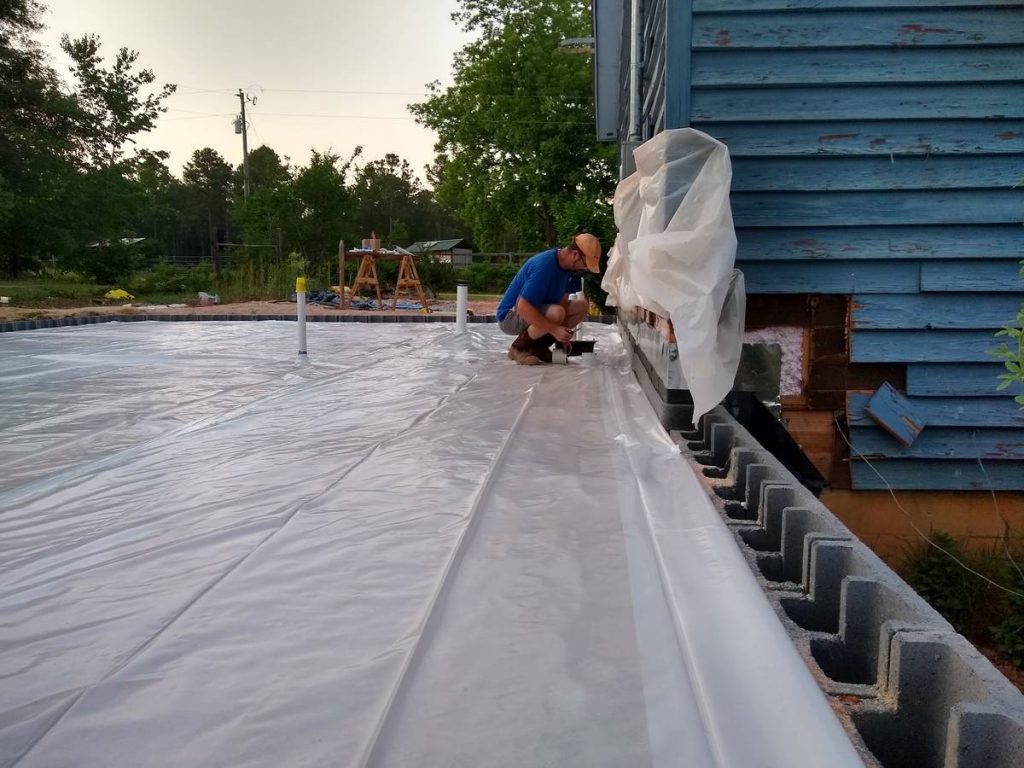
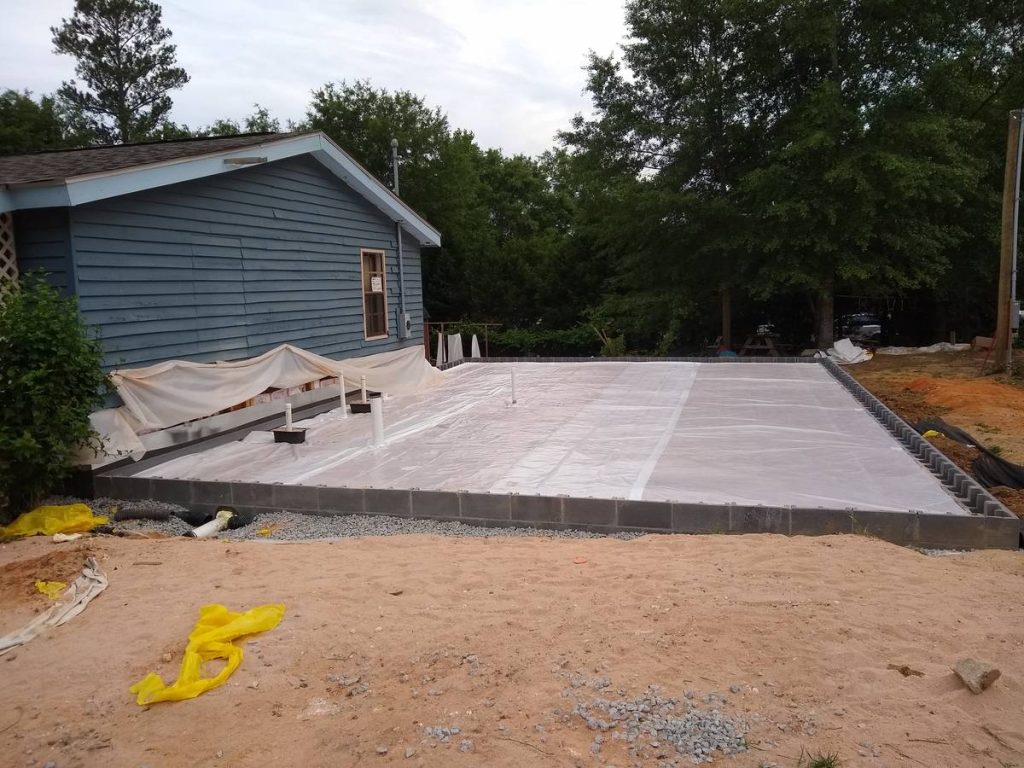
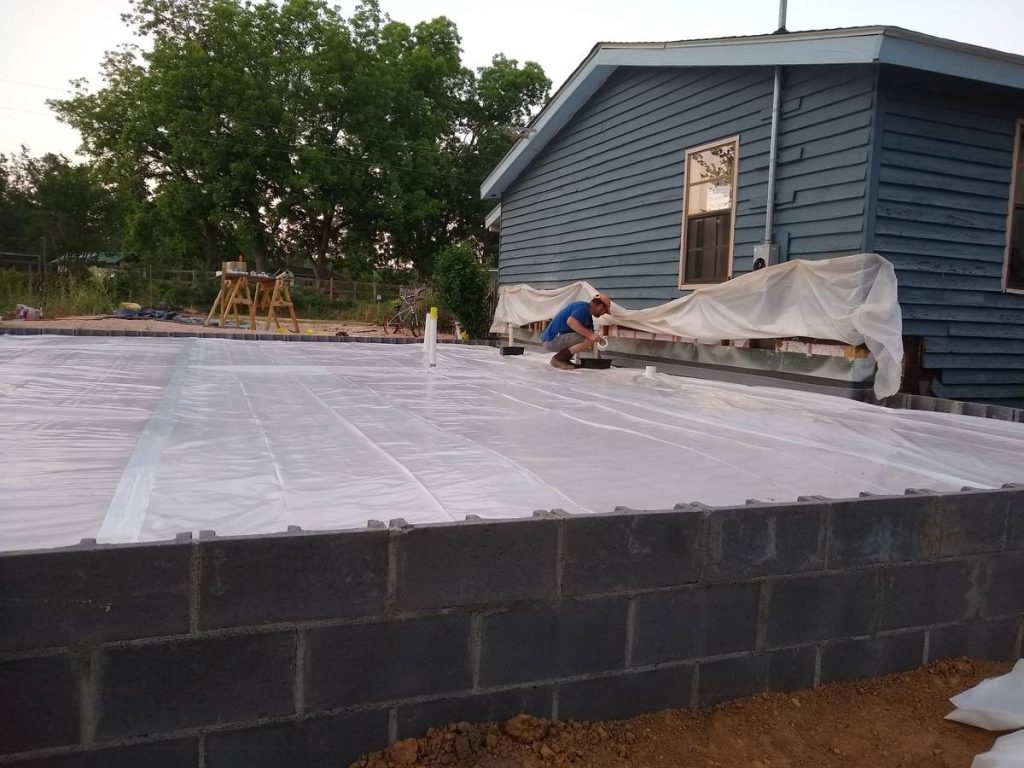
I had a roll of 12′ x 100′ plastic that I planned to use for the purpose. The width of the slab was 24 feet minus the 8 inches for the concrete block. I should have enough plastic for a good 8-inch overlap in the middle. Except that the plastic wasn’t 12 feet wide. It was just a hair over 11 feet wide. This could be a big problem. I couldn’t leave a 1-foot strip of bare sand and pass the inspection.
Larry told me not to freak out and just roll out the plastic and see how much more I’d need. A little quick math tells me that 36 feet multiplied by 3 sheets equals less than I thought I had. To my surprise and delight, the plastic rolled out a full third sheet. Apparently, the person or machine that cut the width too skinny also cut the length too long.
I tacked down the edges of the plastic with some four-inch sod staples and used 4-inch vapor barrier tape to seal the pieces together. Getting the vapor barrier over the pipes was easier than I expected. We just cut little slits in the plastic where the pipes come through and slipped it over. A good layer of tape around the pipe sealed it back up.
Under Pressure.
The last thing to do was to pressurize the drain system. It’s easier than it sounds because it relies on gravity. I plugged all of the drain pipes except one. To that one exception, I added an extension to get it up to 8 feet. Then I filled it with water. The inspector could come and see that the drains were sealed by filling up that 8-foot pipe and watching to see if the water level dropped. The weight of the water in the pipe provides enough pressure that it will push water through any bad connections.
I filled up the eight-foot pipe, then watched in horror as one of the plugs popped out of a pipe and water gushed out onto the vapor barrier. Uh oh. This one plug was different from the others. It fit inside the pipe and tightened down with a wing nut. The weight of the water just forced it out.
I put it back in and torqued it down as hard as I could. I got back up on the ladder and started to fill the pipe again. Everything was going fine until about the last 8 inches of water. I heard a hiss from the offending pipe as air escaped and then POP, the plug jumped out of the pipe, and water geysered onto the plastic. This was a problem.
Or was it? At just this very moment, my friend Nick happened to be walking home with his family after a swim party at our neighbor’s house. He saw me standing on the ladder with a look of bitter defeat on my face. “Whatcha doin’?”
Talk about the right person at the right time. Nick is a chemical engineer who graduated from Georgia Tech. “Maybe you just need to slow down the water as you’re pouring it in so you don’t get all that pressure all at once.” We tried it. I slowed the water down to a trickle and he knelt down next to the plug. As the water filled the pipe, he reached into the pipe to release the air and tighten the plug again.
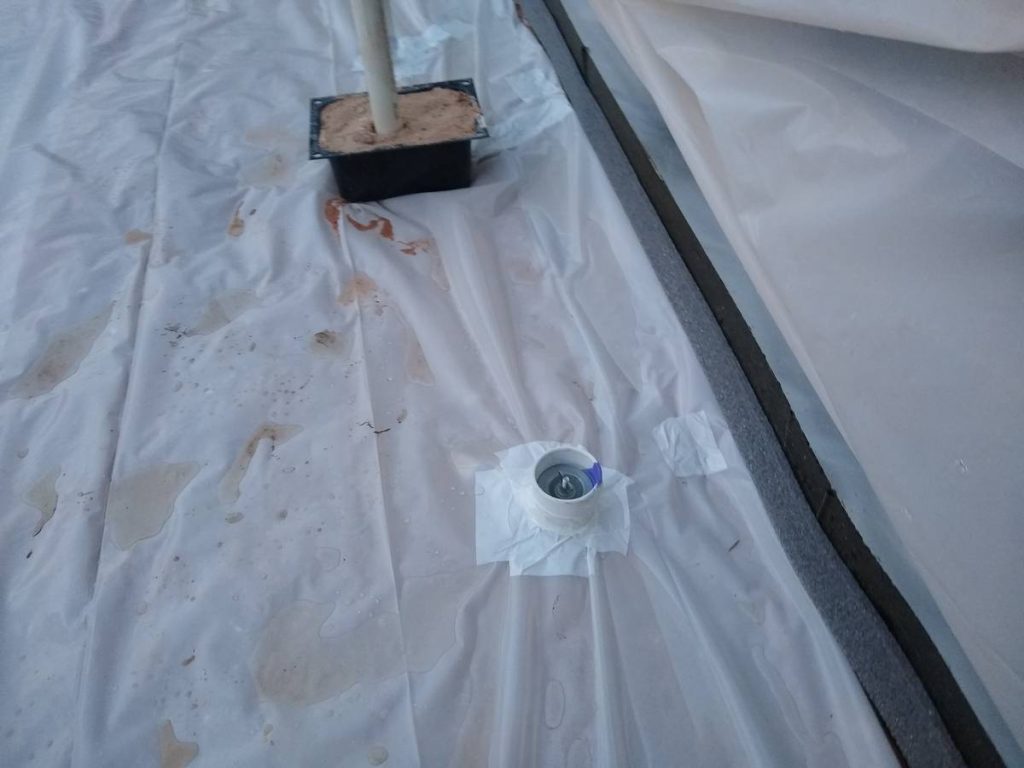
Slowly, slowly, so slowly that his wife said, “I’m going home,” the pipe filled with water. The plug held. I filled up the extension so that the water was even with the very top, and the plug still didn’t pop. I climbed down the ladder and gave Nick a high-five. That plug just needed to stay put for about 18 hours. Long enough to convince the inspector that the drains were good.
Welcome, Welcome!
I can’t say that the inspection was anticlimactic, because I wasn’t there. I was at work. Thankfully, Larry knows the inspector and volunteered to meet him. About halfway through the afternoon, I got a text from Larry, “The only thing is a sleeve around 4″ pipe through foundation. He signed off anyway.” Beautiful news. I had passed!
I called up Tag Bussey, the concrete guy, to confirm that I’d passed my inspection. He told me that he’d be ready to pour on Monday. Great. That meant that I could wait until Saturday to put the sleeve on the drain pipe. A sleeve is just a short section of six-inch pipe that goes around the drain pipe to keep the poured concrete from coming into direct contact with the drain pipe.
I had to buy a 10-foot section of 6-inch pipe to cut off one foot for the sleeve, but that was ok. By Saturday morning, I’d tracked down the pipe and got to work. I had to use my father-in-law’s mini-jackhammer to break through the concrete block, but that actually made it pretty fast and easy. And jackhammers are intrinsically fun. Boys love demolition.
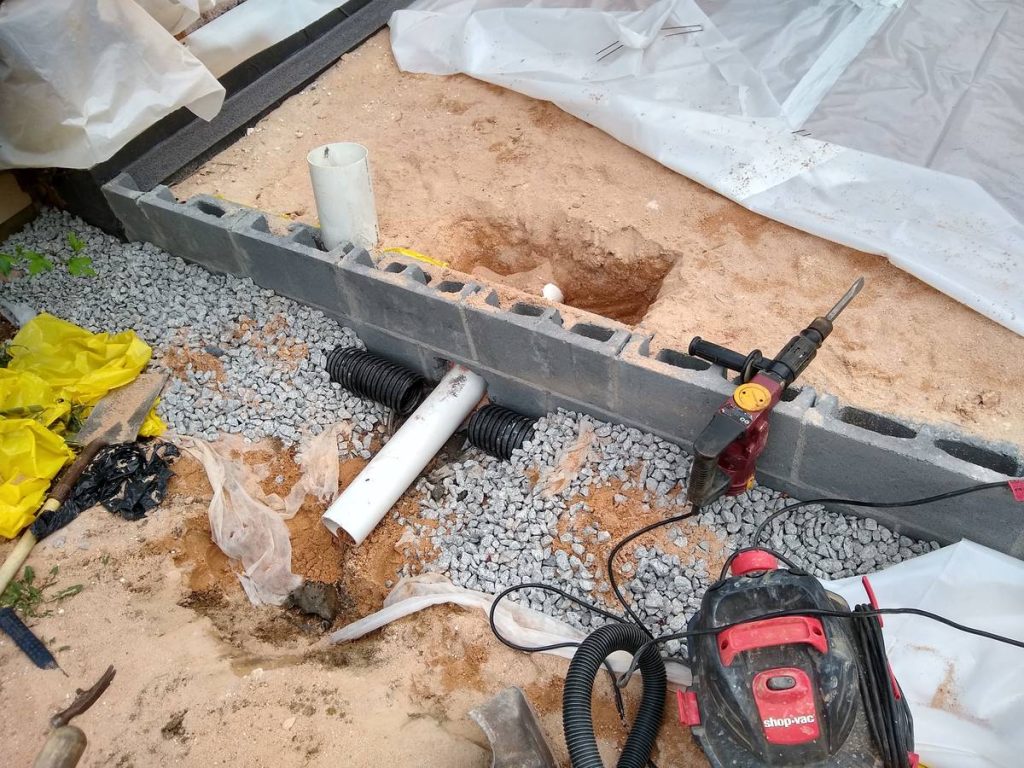
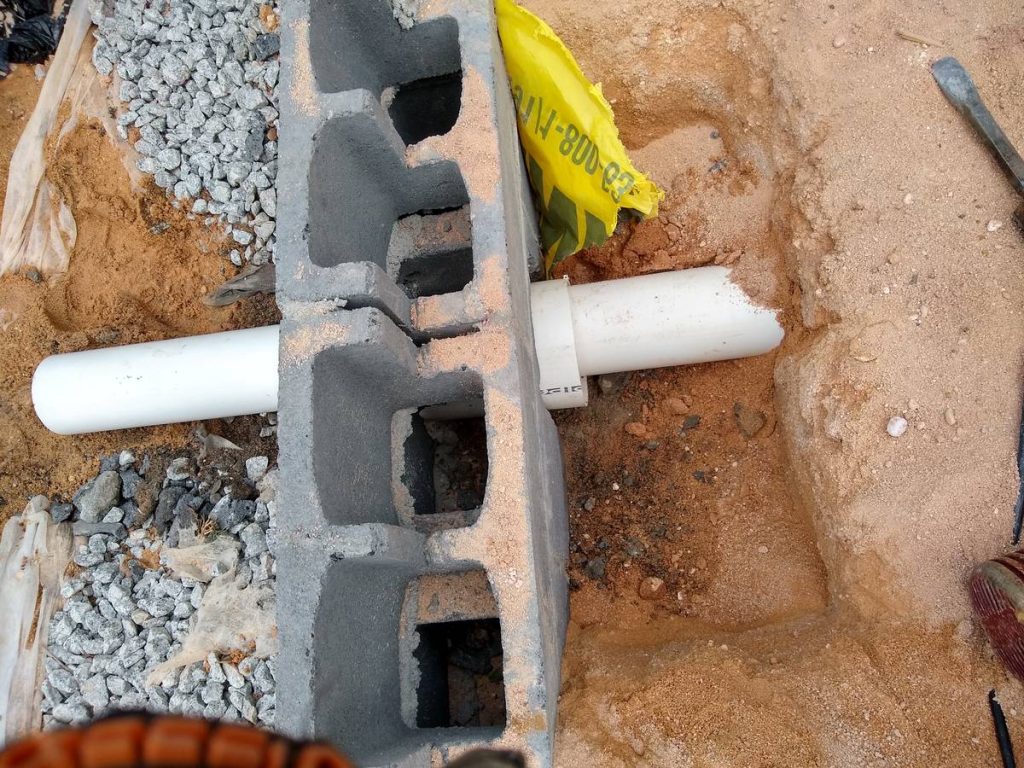
Placing the concrete.
I got a call from Tag saying that he planned to send his crew on Monday. We had a couple of calls on Sunday afternoon because the forecast for Monday called for rain. Not, “build an ark” kind of rain, but pretty close. Monday at 6:30 AM, Tag called me and told me that his team would be there at 8:00. The forecast said that rain should wait until after lunch.
His team showed up and started prepping for the concrete truck. I took the morning off so I could watch. They took a string level and placed two grade stakes in the center of the slab to give them the correct depth for the concrete. Then they unloaded a number of tools that I’d never seen before that they would be using to move the concrete. Then they sat down to wait for the concrete truck.
The clouds above looked downright hostile. If you don’t live in Georgia and have never experienced a Georgia thunderstorm, you still might understand when I say that the sky looked angry. Mean. The kind of sky that gave Noah a reason to hurry those animals up the ladder. The concrete guys didn’t seem worried at all. They moved liquid rock for a living. A little rain wouldn’t ruin their day.
The truck arrived and they leaped into action. They started pouring concrete next to the drains, They worked the concrete right up next to the expansion barrier, following the line that it made across the width of the house. Then they started to place the concrete into the block wall and worked their way around the foundation.





Tag ordered 14 yards of concrete because of the size of the pad and the block wall. A concrete truck really only comfortably carries 10 yards of concrete, so the truck was going to have to do a second trip out. It emptied itself, leaving the back corner to wait for the second load.
The concrete guys kept smoothing out the concrete they had put down. It’s amazing how smooth they could get it with just a couple of hand tools. While they worked, it started to sprinkle, and then the bottom dropped out of the sky. My kids and my neighbor’s kids all ran for cover inside the house. The concrete just sat there, seemingly unconcerned about the weather. It poured rain for at least half an hour.
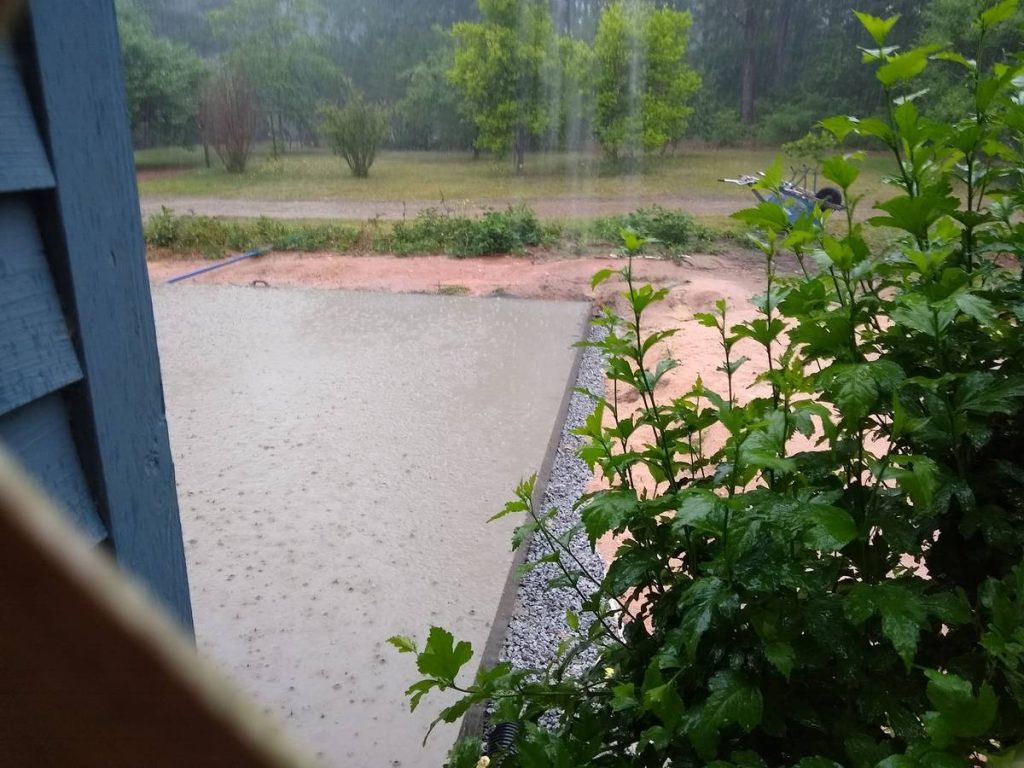
The rain didn’t bother the concrete guys at all. They just sat in their trucks and waited until the worst had passed. By the time it slowed down to a light drizzle, the concrete truck had returned. They finished pouring the back corner and smoothed it flush with the top of the concrete block wall.
The truck still had some concrete left, so they asked me if I wanted them to put it somewhere. My neighbor Michael had prepared me for this possibility, so I asked them to pour a little mini-slab next to my well-house. It turned out to be bigger than I expected, a triangle about 10 feet on a side, 3-4 inches thick. I was thrilled.
At this point, it was time for me to go back to work. I only have so much vacation time, so I’m trying to stretch it out as long as possible. They told me that they might add some dry cement to the top of the slab to help compensate for anything that the rain had done to dilute the concrete mixture. They also pulled out a tool that looked like a large ceiling fan with a handle that they were going to use to make the slab nice and smooth.
I still don’t know the name of the tool, but it really worked wonders.
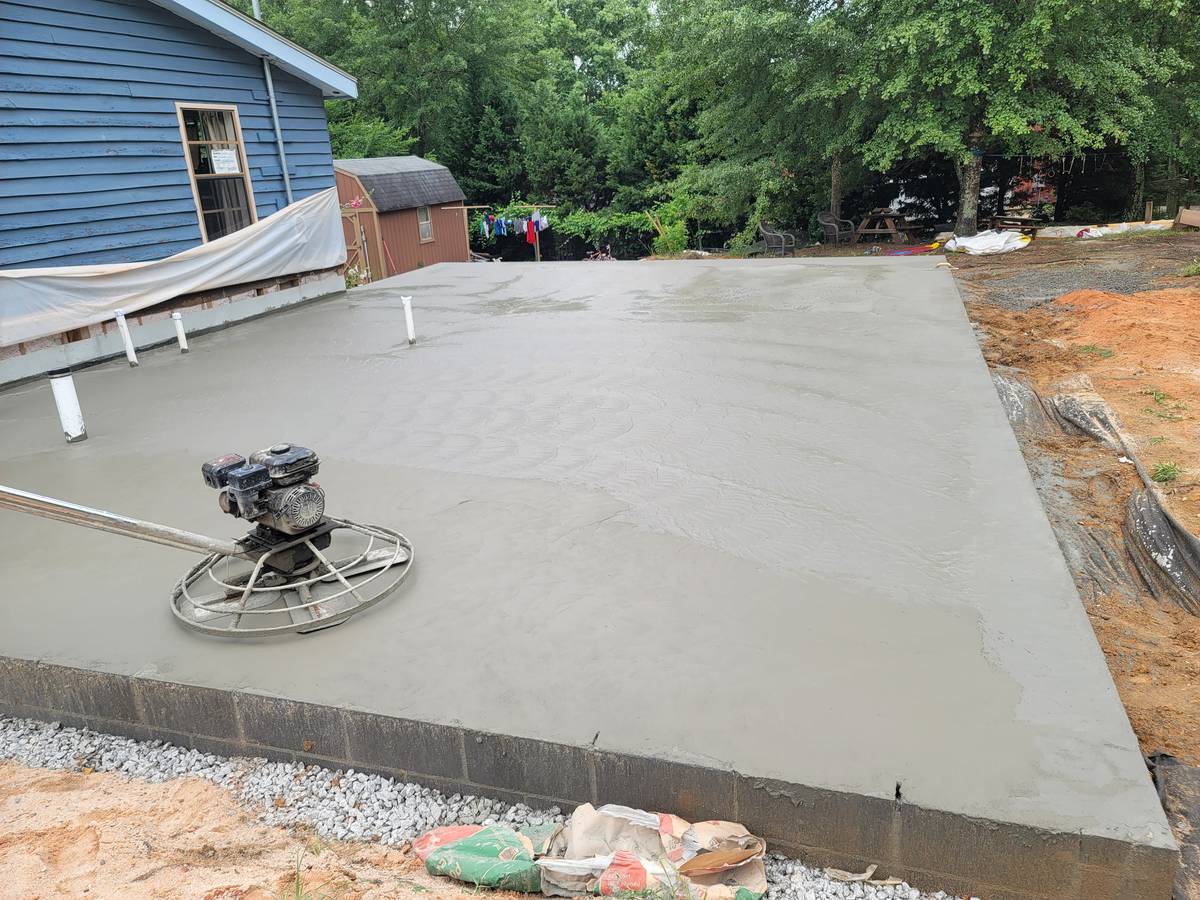
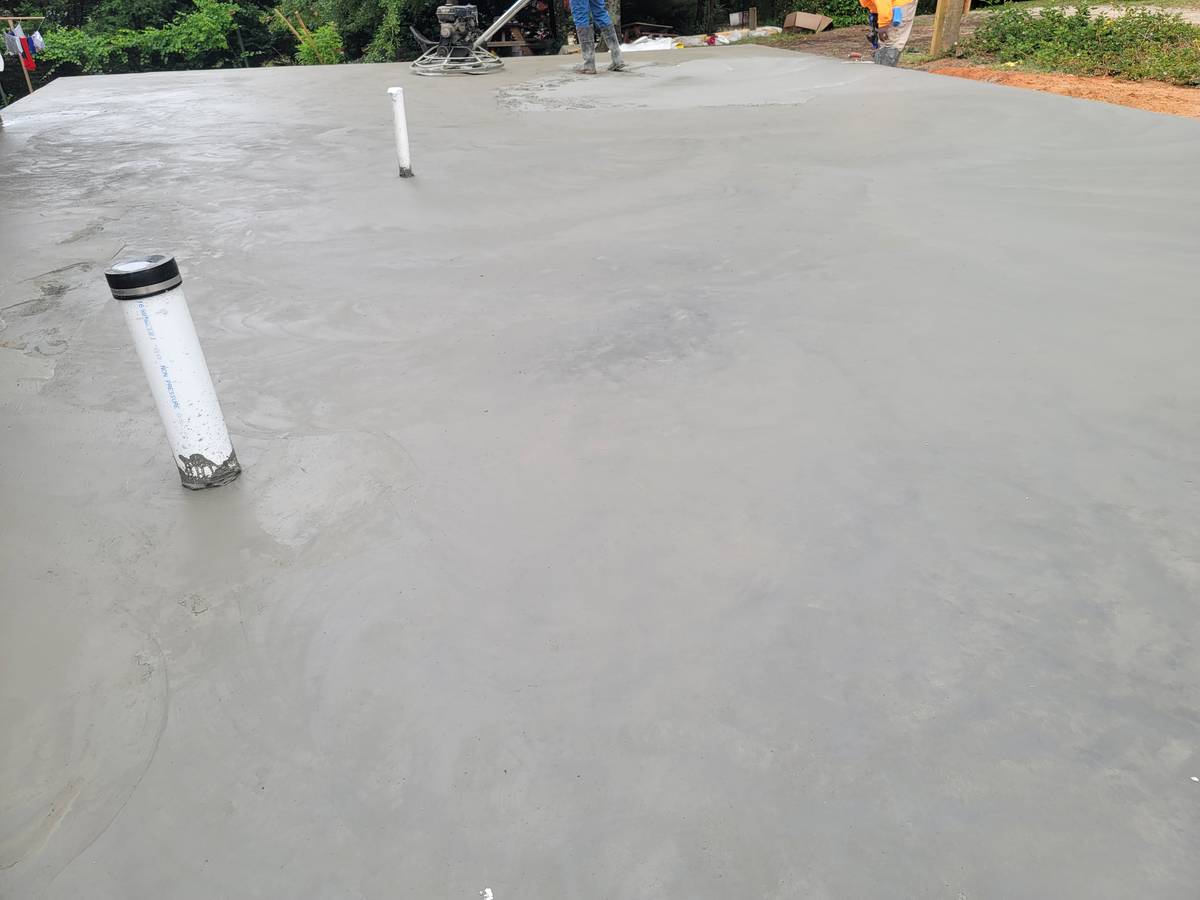
Every hour or so, Larry would send me a picture with an update on their progress. It just kept looking better and better.
The end of the beginning.
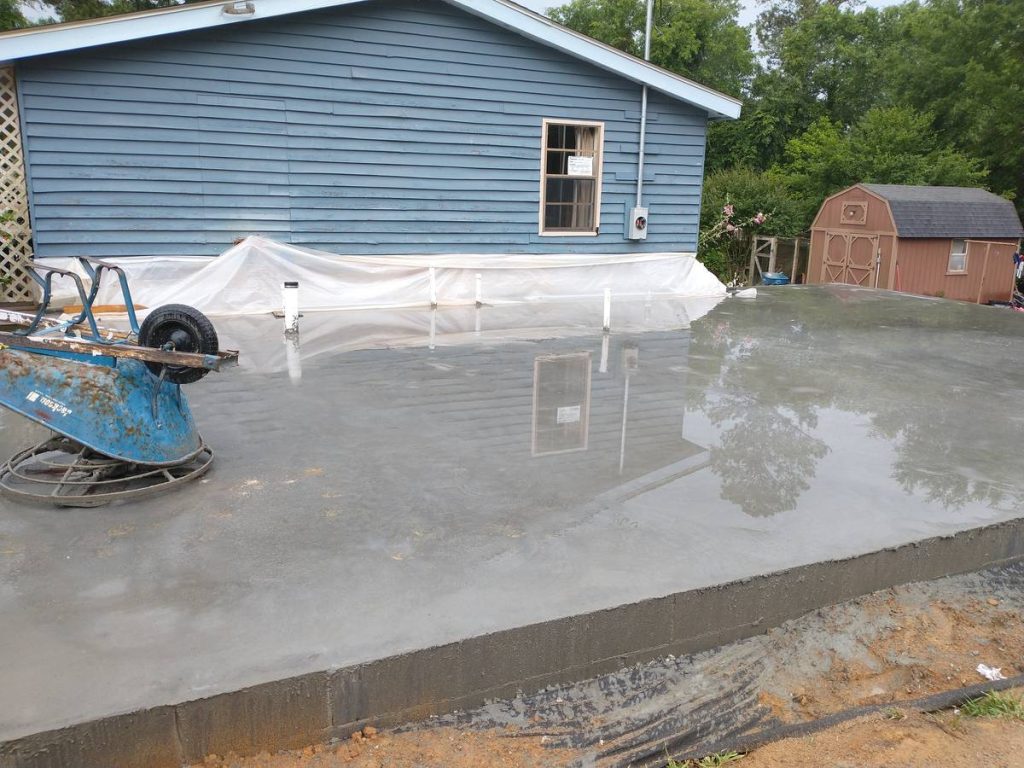
The final picture that Mary took of the slab amazed me. I never thought that you could give concrete a mirror finish. But look at this picture. Even though it’s pretty industrial, the reflection of the house on the concrete is quite lovely.
Finishing the slab felt great. Walking on concrete feels solid… like I’ve really accomplished something major. But at the same time, I feel like I’ve only started. It’s a good start, but I have a long way to go.
I told Mary that I could put a teepee on the slab and take her and the family on a killer vacation to Mexico with the rest of the money. She very prudently said, “NO!” She knew I was kidding. Mostly kidding.
The hard part has only just begun. But I’ve laid a solid foundation for the next step. Coming soon… walls and a roof.
If you want to read more of my adventures building the House of Krupa, check out the archive!
Jesus snatched me out of the darkness and saved me from complete madness. If you want to hear more of that story, check out Demoniac, now available on Amazon.

